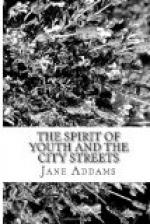I could cite many instances of high-spirited young people who suffer a veritable martyrdom in order to satisfy their artistic impulse.
A young girl of fourteen whose family had for years displayed a certain artistic aptitude, the mother having been a singer and the grandmother, with whom the young girl lived, a clever worker in artificial flowers, had her first experience of wage earning in a box factory. She endured it only for three months, and then gave up her increasing wage in exchange for $1.50 a week which she earns by making sketches of dresses, cloaks and hats for the advertisements of a large department store.
A young Russian girl of my acquaintance starves on the irregular pay which she receives for her occasional contributions to the Sunday newspapers—meanwhile writing her novel—rather than return to the comparatively prosperous wages of a necktie factory which she regards with horror. Another girl washes dishes every evening in a cheap boarding house in order to secure the leisure in which to practise her singing lessons, rather than to give them up and return to her former twelve-dollar-a-week job in an electrical factory.
The artistic expression in all these cases is crude, but the young people are still conscious of that old sacrifice of material interest which art has ever demanded of those who serve her and which doubtless brings its own reward. That the sacrifice is in vain makes it all the more touching and is an indictment of the educator who has failed to utilize the art instinct in industry.
Something of the same sort takes place among many lads who find little opportunity in the ordinary factories to utilize the “instinct for workmanship”; or, among those more prosperous young people who establish “studios” and “art shops,” in which, with a vast expenditure of energy, they manufacture luxurious articles.
The educational system in Germany is deliberately planned to sift out and to retain in the service of industry, all such promising young people. The method is as yet experimental, and open to many objections, but it is so far successful that “Made in Germany” means made by a trained artisan and in many cases by a man working with the freed impulse of the artist.
The London County Council is constantly urging plans which may secure for the gifted children in the Board Schools support in Technological institutes. Educators are thus gradually developing the courage and initiative to conserve for industry the young worker himself so that his mind, his power of variation, his art instinct, his intelligent skill, may ultimately be reflected in the industrial product. That would imply that industry must be seized upon and conquered by those educators, who now either avoid it altogether by taking refuge in the caves of classic learning or beg the question by teaching the tool industry advocated by Ruskin and Morris in their first reaction against the present industrial system. It would mean that educators must bring industry into “the kingdom of the mind”; and pervade it with the human spirit.




